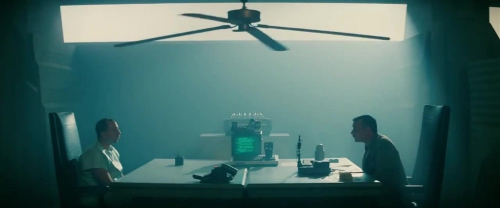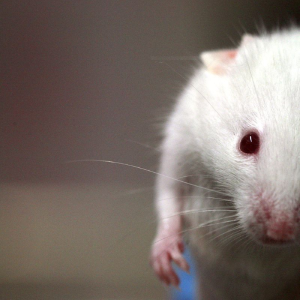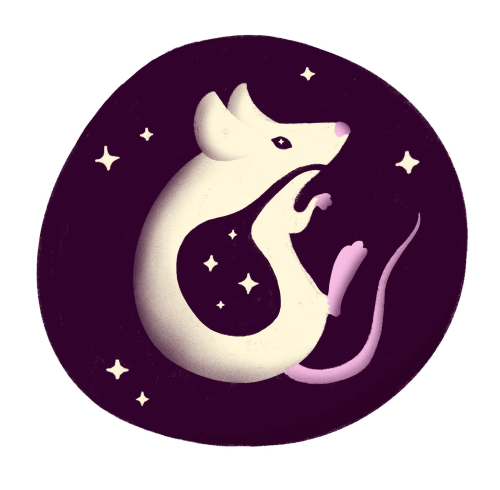
The Voigt-Kampff test as seen in Blade Runner (1982). All copyrights to film held by Warner Bros.
In the opening scene of Blade Runner, a fictional diagnostic called the Voigt-Kampff test distinguishes human from android. The test, as imagined in Philip K. Dick’s sci-fi novel and later adapted into the film adaptation, exploits a primary autonomic response: the so-called ‘shame’ or ‘blushing’ reaction to a “morally shocking stimulus.” In the novel, the ‘moral shock’ stimulus invariably involves nonhuman animals:
A little boy shows you his butterfly collection, including his “killing jar.”
You read a novel in which characters enter a seafood restaurant and lobster is dropped into a pot of boiling water for the characters to watch.
The essence of humanity, according to the makers of the Voigt-Kampff test, lies in a universal ability to feel empathy with nonhuman animals. Nonhuman animal pain and death are used as test prompts to solicit a measurable, objective, and neurobiological read-out of empathy.[1]
I bring up Dick’s fictional test to put it in conversation with another speculative idea: Pain-Free Mouse, a model organism genetically engineered to not feel pain, conceived by evolutionary bioengineer Dr. Kevin Esvelt at the MIT Media Lab. Pain-Free Mouse is the strange offspring of synthetic biology and Esvelt’s consequentialist outlook, a moral philosophical framework that evaluates actions based on the amount of ‘good’ or ‘bad’ outcomes they produce. According to Esvelt, suffering, no matter who or what experiences it, is intrinsically ‘bad’ and should therefore be reduced or eliminated. A focus on pain alleviation is a first step towards reducing suffering.
To make a pain-free mouse, bioengineers would suppress genes responsible for acute and chronic pain reception. The mouse’s genome would encode a switch so that a small molecule (e.g., an antibiotic) could turn this mechanism on at the desired moment—usually when the animal must undergo a painful procedure, including being sacrificed, i.e., killed.[2] The project’s aim is to develop a model organism for use in scientific experimentation, such as OncoMouse, a patented mouse line bred to spontaneously grow tumours and, consequently, experience excruciating pain. Pain-Free Mouse would supposedly make scientific experimentation more ‘humane’ for both mice and men.

Lab mouse. Source: Wikimedia Commons.
Pain-Free Mouse raises a bewildering storm of questions and concerns, from the ethics of shaping animals to fit human desires (e.g., Ritvo 1987); to the limits of objectifying animal pain as strictly biological (e.g., Sharp 2018); to the reduction of care to a rational calculus, and simplification of laboratory animals to mere victims (Haraway 2008). There is a rich and important body of scholarship that addresses these questions, which this post cannot do justice.[3]
Instead, what occupies me here are the internal contradictions at the heart of Pain-Free Mouse. If it were realized, Pain-Free Mouse would erase the very grounds on which mice had merited moral consideration within some consequentialist frameworks: the ability to feel pain. Second, its making would remove the very grounds on which being ‘human’ was measured—at least according to the Voigt-Kampff test. In the Blade Runner universe, how would a human respond to a morally shocking stimulus that involves Pain-Free Mouse? Would experimentation on Pain-Free Mouse become more or less ‘humane’? What being ‘human’ means becomes an open question.
I suspect—hope, desire—that Pain-Free Mouse creates the conditions for its own escape from Man. An escape that, furthermore, can lead the way towards a more-than-human, other-than-Human ethics in a time of climate catastrophe.
Pain-Free Mouse became the biggest, smallest, most vexing experiment I never planned to grapple with. I first encountered Pain-Free Mouse as a 2019 Berggruen Institute Research Fellow when I was placed in Esvelt’s lab after doing anthropological research on Arctic sea ice and climate change. In examining Pain-Free Mouse, I want to approach speculative fiction (SF) as a mode of inquiry in itself that can engage my anthropological colleagues and former labmates in the process of imagining human-animal relations otherwise (Vint 2010; Haraway 2016).
In the spirit of SF, I run with the premise that pain and suffering is the basis of empathy and thus, humanity, to see how far it takes us and where it founders.
Beyond pain
H. G. Wells’ (1896) “The Island of Dr. Moreau” is an early SF story about human intervention in the evolution of nonhuman animals. In the story, the narrator, Edward Prendick, is troubled by a panther that he never sees but hears howling, incessantly. Its cries, clearly evincing its suffering, are so sharp and prolonged that Prendick leaves his living quarters to get away from the unmistakable sound of animal pain.
Pain as the basis of moral consideration in animal rights movements is popularly traced to 18th-century philosopher, Jeremy Bentham, who famously asked: “The question is not, Can they reason?, nor Can they talk? But, Can they suffer?” In his theory of Utilitarianism, which sought to maximize pleasures over pain, Bentham moved the grounds of moral consideration away from reason. Pain could be felt not only across differences in skin colour or sex, but, furthermore, could speak across species divides. Pain thus provided a more universal, empirical, and objective basis for ethical action.
This understanding of pain has proven highly productive to think with, and was popularly reworked in Peter Singer’s 1975 “Animal Liberation”. Notably, Singer outlines a neurobiological hierarchy according to which different animals deserved greater or lesser moral consideration. Those with a higher density of cortical neurons and displaying a centrally-organized nervous system, such as humans, merit more moral regard compared to mice or worms.
Thinkers of many stripes have critiqued Singer on numerous aspects of his argument. For instance, his framework, far from being non-anthropocentric, assigns moral value based on likeness with human beings (Plumwood 2009). In addition, a narrow focus on minimizing suffering deflects attention away from other forms of response to animals (Haraway 2008). What interests me, though, as an anthropologist who studied Arctic sea ice, are the plants, stones, and other beings without nervous systems who remain invisible in a pain-focused framework.
Riffing on the centrality of feeling in utilitarianism and Blade Runner, how can one feel for rocks, ice, the ocean or atmosphere, if at all? Melting ice caps, ozone holes, acidifying oceans, and open-pit mines expose the inadequacies of ethical frameworks based only on pain and suffering. Suffering is reserved for the living; it is for those who can die. Nonlife is the limit at which narratives about species extinctions and post-human ethics run out of steam (e.g., Rose et al. 2017). This faltering, I suspect, has more to do with the inheritance of Euro-centric life/nonlife divisions than certainty around the ability of rocks or ice to feel or suffer. There are after all many worlds in which the life/nonlife distinction never mattered, or mattered differently (Povinelli 2016; Tallbear 2017).
If one wants to empathize with a stone or ice, then pain and the possibility of biological death may not be enough. But what if Pain-Free Mouse offers a speculative opportunity for enlarging empathy beyond pain and finitude? What if, in its realization, bioengineers move the ethics of human-animal relations beyond questions of pain, neurobiologically-defined?[4] Pain-Free Mouse might escape the constraints of the ethical framework that launched its existence. And what if anthropologists are not so quick to condemn Pain-Free Mouse for annihilating “response-ability” (Haraway 2016)? Pain-Free Mouse, together with stones and androids, would further anthropological thinking on the consideration of enervated beings. Thus, in strange, unexpected, and awkward ways, Pain-Free Mouse might actually push together social and natural scientists to imagine empathy beyond the already known.
Risking imagination
Empathy shares in common with speculative fiction the need for imagination. Shared neurobiology offers one means for imagining what it is like to be a panther or a mouse. But imagination is richer, more capacious, and underdetermined than that. Imagination allows for funny and poignantly written thought experiments in Andre Alexis’ (2015) “Fifteen Dogs”; it enables Paul Coetze (1999) to simultaneously occupy irreconcilable character positions in “The Lives of Animals”—much to the frustration of Singer (1999) who cannot fictionalize beyond what he already knows.
Imagination, as the ability to make thinkable what does not yet exist, challenges us to look beyond mimetic forms of sharing (Haraway 2008, 75), and develop modes of caring not based on shared likeness (Raffles 2010). It asks us to go beyond identification or projection of oneself onto others, human or nonhuman (Schrader 2015).
Imagination comes with risks. But it might offer a way to take seriously Pain-Free Mouse, as well as ice and androids.
Re-imagining pain/being ‘human’
Let me close with one last SF experiment.
In Octavia Butler’s (1999) SF novel, “Parable of the Sower,” the main protagonist, Lauren, has an unusual, fictional condition: hyper-empathy syndrome. She experiences the pain and pleasure of others as if it is her own. Although “sharing” makes her extremely vulnerable, it also heightens Lauren’s sensitivity to the world around her. Her sense of self is continuous with a larger environment.
Lauren’s “sharing” suggests that empathy requires openness, vulnerability, even passivity as something that happens to you. Her story enlarges empathy and ethical action beyond neurobiologically-defined pain in the abstract. Lauren shows how empathy as a relational encounter can provide an alternative ethical horizon that is richer, but also riskier in its potential for mutual transformation.
What if, then, we re-imagine the Voigt-Kampff test through Lauren’s “sharing” and Pain-Free Mouse? Such a test would locate humanity’s constitutive difference in the capacity to blur the very divisions it is supposed to reinforce without resorting to shared neurobiological pain as essential for empathy. Instead of looking for differences to shore up Man, one would look for the opening up of being human. And in doing so, the test would spell its own dissolution.

“Outside-In.” Illustration by Doyung Lee.
Footnotes
[1]The Voigt-Kampff test does not go untroubled in Dick’s “Do Androids Dream of Electric Sheep?” In fact, events in the story constantly test the Voigt-Kampff test, human/android distinctions, and definitions of ‘empathy.’
[2] For critical commentary on the term ‘sacrifice,’ see Haraway (1997, 2008), Lynch (1988).
[3] See, for instance, the works of Despret (2016), Wolfe (2003), Franklin (2007), and DeMello (2012) as relevant departure points. Early research on Pain-Free Mouse, specifically, has also flagged institutional and organizational considerations when it comes to introducing this new model organism into scientific practice (see Najjar 2019).
[4] Though this should not be taken as a reason to create Pain-Free Mouse, which would be a contradiction in terms.
Acknowledgments
Thank you to Kevin Esvelt, Rey Edison, and Devora Najjar for inviting me into the Pain-Free Mouse project and providing constructive comments on this piece. Darcie Deangelo, Adam Fleischmann, Fiona Gedeon Achi, Jia Hui Lee, Sarah Vitak, and Jonathan Wald all provided thoughtful feedback on this post throughout its development. Thank you to Doyung Lee for the illustration and letting me share it for this blog post. Last but not least, I am thankful to John Favini and Melanie Ford for their help in the editing process, and giving me the opportunity to write for Platypus.
References
Alexis, Andre. 2015. Fifteen Dogs. Toronto, ON: Coach House Books.
Butler, Octavia. 2019. Parable of the Sower. New York, NY: Grand Central Publishing.
Coetzee, J. M. 1999. The Lives of Animals. Princeton, NJ: Princeton University Press.
DeMello, Margo. 2012. Animals and Society: An Introduction to Human-Animal Studies. New York, NY: Columbia University Press.
Despret, Vinciane. 2016. What Would Animals Say If We Asked the Right Questions? Minneapolis, MN: University of Minnesota Press.
Dick, Philip K. 1968. Do Androids Dream of Electric Sheep? New York, NY: Ballantine Books.
Franklin, Sarah. 2007. Dolly Mixtures: The Remaking of Genealogy. Durham, NC: Duke University Press.
Haraway, Donna. 2008. When Species Meet. Minneapolis, MN: University of Minnesota Press.
———. 2016. Staying with the Trouble: Making Kin in the Chthulucene. Durham, NC: Duke University Press.
Najjar, Deborah Anne. “Towards a More Ethical Animal Model in Biomedical Research.” Master’s thesis, 2018, MIT.
Plumwood, Val. 2009. “Nature in the Active Voice.” Australian Humanities Review 46: 113–29.
Povinelli, Elizabeth. 2016. Geontologies: A Requiem to Late Liberalism. Durham, NC: Duke University Press.
Lynch, Michael. 1988. “Sacrifice and the Transformation of the Animal Body into a Scientific Object: Laboratory Culture and Ritual Practice in the Neurosciences.” Social Studies of Science 18 (2): 265–89.
Raffles, Hugh. 2010. Insectopedia. New York, NY: Vintage Books.
Ritvo, Harriet. 1987. The Animal Estate: The English and Other Creatures in the Victorian Age. Cambridge, MA: Harvard University Press.
Rose, Deborah Bird, Thom van Dooren, and Matthew Chrulew, eds. 2017. Extinction Studies: Stories of Time, Death, and Generations. New York: Columbia University Press.
Scott, Ridley, director. Blade Runner. 1982. Warner Bros.
Schrader, Astrid. 2015. “Abyssal Intimacies and Temporalities of Care: How (Not) to Care about Deformed Leaf Bugs in the Aftermath of Chernobyl.” Social Studies of Science 45 (5): 665–90.
Sharp, Lesley A. 2019. Animal Ethos: The Morality of Human-Animal Encounters in Experimental Lab Science. Oakland, CA: University of California Press.
Singer, Peter. 1999. “Reflections.” In The Lives of Animals. Princeton, NJ: Princeton University Press.
———. 2009. Animal Liberation: A New Ethics for Our Treatment of Animals. New York, NY: Harper Collins.
Tallbear, Kim. 2017. “Beyond the Life/Non-Life Binary: A Feminist-Indigenous Reading of Cryopreservation, Interspecies Thinking, and the New Materialisms.” In Cryopolitics: Frozen Life in a Melting World. Cambridge, MA: MIT Press.
Vint, Sherryl. (2010). Animal Alterity: Science Fiction and the Question of the Animal. Liverpool: Liverpool University Press.
Wells, H. G. 2012. The Island of Dr. Moreau. Project Gutenberg EBook. https://www.gutenberg.org/files/159/159-h/159-h.htm.
Wolfe, Cary. 2003. Animal Rites: American Culture, the Discourse of Species, and Posthumanist Theory. Chicago, IL: University of Chicago Press.

1 Trackback